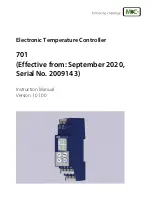
EAAM057608EN
GC250 Technical Manual 135
11.1.5
Manual pump control
Pump can be activated and deactivated according to operator needs. However, the controller
prevents the start if the level (see previous paragraphs) is “stop” or “maximum”.
11.1.6
Protections
Moreover you can set the maximum fuel pump activation time with parameter P.0404. This
parameter should be used to set the time needed for the pump to fill the equipment tank, in
the worst conditions: empty tank and engine started at maximum power. If the pump remains
operational (either manually or automatically) for more then said time, the controller stops it
(without changing the control mode), and issues warning W064: probable pump failure or
pump not sucking from the storage tank. As soon as the alarm is acknowledged by the
operator, the pump restarts.
In many cases you need to be able to block the pump (with a signal on the display) due to
certain situations of the system, such as when the storage tank is empty. In these case you
need to:
Configure a digital input of the controller with feature DIF.4051
– “Fuel pump warning”
(in parameter P.2001 or equivalents).
Associate a delay to that input (in parameter P.2002 or in the equivalent parameters).
If the input remains active for the time configured, the controller issues a warning and stops
the pump (without changing the command mode).
11.2
Load thresholds
This function must not be mismatched with the “Load function” available for the parallel
systems described in the “Parallel functions handbook”.
This function allows to monitor the trend of the active power in order to diagnose:
A low load condition
A high load condition, to disconnect, in case, a part of the loads.
It is necessary to choose a priori the condition to be monitored (using the P.0481 parameter:
set it to zero to select the low power monitoring, set it to 1 to select the high power monitoring).
“0-Low power” is selected by default, but with a 0% reaction threshold, so the feature is
disabled.
In some cases, it is useful to deactivate the function when not needed. In these cases you
need to configure a digital input with feature DIF.2703
– “Enable the loading thresholds” in
parameters P.2001 or equivalents. If such an input already exists, the feature is enabled only
when it is “active”.
11.2.1
Low load
The purpose of this function is to diagnose a low power condition (low load) and
communicating the problem through one of the controller's digital outputs (with more gensets
in parallel this output could be used to deactivate some of the gensets). To associate an output
to this function, the code DOF.3121
– “Load thresholds” must be configured in the parameter
P.3001 (or the corresponding parameter for the other outputs). If no output is configured in
this way, the function will not work.
The controller watches the total active power delivered by the generator, comparing it to two
thresholds (which set, therefore, a hysteresis band): the output is activated (therefore
signalling the low power condition) if the power stays below the lower threshold for the set
time. In the same way, the output is disabled if the power rises above the upper threshold for
the set time. These thresholds and delays are set with following parameters:











































